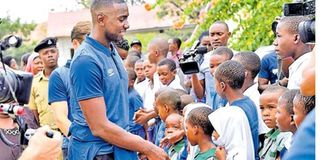Inclusivity for deafblind children

Everton Football Club members visit Uhuru Mchanganyiko Primary school in Dar es Salaam during their visit to Tanzania last year. Uhuru Mchanganyiko is one of the few schools in the country that have integrated deafblind children in their teaching programme to ensure the get equal access to education. PHOTO|FILE
What you need to know:
- Global Partnership for Education (GPE) reveals that despite notable progress in the last few years, millions of children with disabilities are still denied their right to education.
Dar es Salaam. A majority of children with disability have been facing numerous challenges in accessing their basic rights, especially education.
Global Partnership for Education (GPE) reveals that despite notable progress in the last few years, millions of children with disabilities are still denied their right to education. For GPE, ensuring that marginalised children have access to quality education is a priority.
This is why GPE works closely with partner countries to help them capture data more accurately, and has programmes that are helping to make learning inclusive for all in several partner countries.
That is why Tanzania’s innovation has for the first time put children with deafblindness to learn together with others that are not affected by disability.
The project dubbed, ‘Inclusive Education for Children with Deaf Blindness’, enables teaching assistants to sit together with the children to support them in learning.
Sense International Tanzania country director Geoffrey Atieli told The Citizen on the sidelines of the fourth Innovation Week 2018 that took place at the Commission for Science and Technology (Costech) that a majority of children with deaf blindness are not taken to school and therefore remain dependent for the rest of their lives.
The innovation week was organised by Human Development Innovation Fund in collaboration with UKaid.
He said the inclusive education for children with deafblindness entails attaching a teaching assistant to a child with the disability in order to support them to learn together with other normal children in a mainstream classroom.
“To enable the initiative to work, we work together with ward education coordinators to identify the children and start the process of taking them to school after finding a teacher to attach them with,” he said.
He said that the process of finding the children had not been easy as a majority of them had been hidden in homes for fear of losing them or being stigmatised.
“We found one child in Same District, tied to a tree for fear she would wander around and get lost,” he said.
According to him, since the process started three years ago, they have found 80 children and put them in 69 different inclusive public schools.
He said that the programme, which started as a pilot project in 2016 and is expected to end in 2019, has so far been implemented in Dar es Salaam and Kilimanjaro.
“The project is meant to demonstrate the method of teaching a child with deafblindness in an inclusive setting,” he said.
Mr Atieli said that the project works closely with the government and especially the ministry of Education, Science and Technology as well as the Prime Minister’s Office, Regional Administration and Local Government (PMO-RALG).
He noted that through the programme the government aims to develop a policy of having a cadre of teaching assistants in the education system.
“So far, we are the only organisation focusing on children with deafblindness who can’t see or hear. This is because they don’t fall in the category of blind or deaf which already have support,” he said.
According to him, the project focuses on making sure children with deafblindness are not left behind.
He explained that even statistics showed that such children have not been categorised in the census programme and therefore the country has no data on them.
Explaining, he said, the census normally categorizes them as “others” in its evaluation because they have a very rare and unique disability.
However, he noted that countries with the right census have a proportion of 0.01 to 0.04 per cent of the total population, which if applied to Tanzania’s population of about 50 million, it means that there are about 20,000 people with the disability. Meanwhile, Ilala District, Special Needs Education Officer Salehe Haruna said that his district had received a total of 16 children with the condition who have been taken to different schools.
He said, so far, through Sense they have been able to acquire teaching materials as well as offering in-service training to teachers.
“This has been an ideal programme that has helped the government to locate children with disability and ensure they get the right education,” he said.
According to him, the biggest obstacle that they faced when the programme was introduced was lack of adequate infrastructure for the children, which the government has tried to put in place.
He noted that Sense has also been providing wheelchairs to the children to enable them move around the school as they are not able to awalk alone.
He added that the government has benefited from the programme through having more employment for teachers who are trained to deal with the children.
HDIF team leader David McGinty said it was imperative that Tanzania comes up with new ideas to tackle challenges that impact the society.
He said technology was helping the children adopt improved learning.



